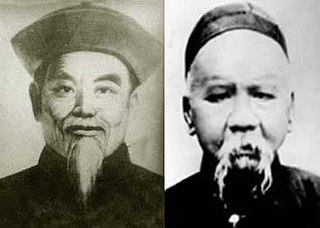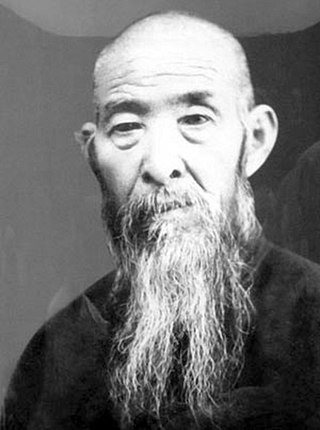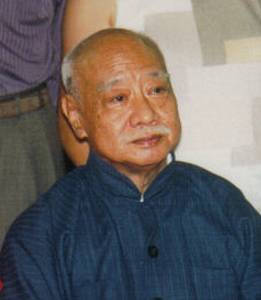
Nei jia is the collective name for the internal Chinese martial arts. It relates to those martial arts occupied with spiritual, mental or qi-related aspects, as opposed to an "external" approach focused on physiological aspects. The distinction dates to the 17th century, but its modern application is due to publications by Sun Lutang, dating to the period of 1915 to 1928. Nei jing is developed by using nei gong or "internal changes", contrasted with wài gōng or "external exercises".

Tai chi is an internal Chinese martial art practiced for self-defense and health. Known for its slow, intentional movements, Tai chi has practitioners worldwide and is particularly popular as a form of gentle exercise and moving meditation, with benefits to mental and physical health.

Zhang Sanfeng refers to a legendary Chinese Taoist who many believe invented tai chi. However, other sources point to early versions of Tai Chi predating Sanfeng. He was purported to have achieved immortality.

Wu (Hao)-style tai chi is one of the five primary styles of tai chi. It was created in the mid-nineteenth century by Wu Yuxiang, a member of a wealthy and influential family in Yongnian, Hebei, China. Wu trained for approximately ten years with the founder of Yang-style tai chi, and then for over a month with a Chen-style master. Wu also obtained a manual on internal martial arts that formed the core of what are now known as the tai chi classics and include Wu's own writing on the subject. From these sources Wu and his family developed their own style, and may also have developed much of the cultural and intellectual foundation of tai chi as well.

Yang-style tai chi is one of the five primary families of tai chi. Including its variations, it is the most popular and widely practised style of tai chi in the world today. It is second in terms of seniority, after Chen-style tai chi.

Wu Jianquan was a famous teacher and founder of the neijia martial art of Wu-style tai chi in late Imperial and early Republican China.

Sun Lutang (1860-1933) was a master of Chinese neijia (internal) martial arts and was the progenitor of the syncretic art of Sun-style tai chi. He was also considered an accomplished Neo-Confucian and Taoist scholar, and was a distinguished contributor to the theory of internal martial arts through his many published works.

Wu Kung-tsao or Wu Gongzao (1902–1983) was a famous Chinese teacher of t'ai chi ch'uan. He taught in Beijing, Shanghai, Changsha and Hong Kong. The second son of Wu Chien-ch'üan, he was the grandson of the first teacher of Wu-style t'ai chi ch'uan, Wu Ch'uan-yü. Wu Kung-tsao was the younger brother of Wu Kung-i and the older brother of Wu Ying-hua. The Wu family were originally of Manchu ancestry.

Wu Quanyou was an influential teacher of tai chi in late Imperial China. His son is credited as the founder of the Wu-style tai chi. As he was of Manchu descent, and would have been named by his family in Manchu, the name "Wú" (吳) was a sinicisation that approximated the pronunciation of the first syllable of his Manchu clan name, U Hala.

Wu Daxin or Wu Ta-hsin (1933–2005) was a Chinese tai chi teacher who lived most of his life in Hong Kong. He was the great-grandson Wu-style tai chi founder Wu Quanyou and the grandson of the well-known teacher Wu Jianquan. He directed the Wu family's lineage for four years from the Wu family headquarters in Hong Kong after the death of his cousin Wu Yanxia.

Zhaobao tai chi is a style of tai chi that is often considered to be a modern style, but actually has a strong documented lineage that confirms its authenticity as an ancient style of tai chi and as a true transmission from Wang Zongyue.

The tai chi classics are a collection of over 100 articles on the Chinese martial art of tai chi written by the art's master practitioners over the centuries. They cover everything from the underlying Taiji philosophical principles, to methods of practice and application. Previously passed down in secret from generation to generation in whole or in parts through various lineages, they achieved classical status as they became public starting in the mid-1930s. Together they now serve as the single authoritative guide for the development and usage of tai chi skills. Written mostly in classical Chinese, they are used today mostly by the serious martial art practitioners of modern 6 Lineages that all trace their lineages to the ancient style taught by the Chen family and Yang family starting in the mid-19th century.
Wang Maozhai was one of Wu Quanyou's of Wu-style t'ai chi ch'uan three primary disciples. When Wu Quanyou's son Wu Jianquan moved from Beijing to Shanghai in 1928 he remained to lead the Wu-style Beijing group. He was the founder of the Beijing Tai Miao Tai chi Research Centre. In 1929, the first documentary book on Wu-style Tai chi "The record of Wu Style Tai Chi Chuan" was published by Wang Maozhai with Wu Jianquan and Guo Fen. His primary disciple was Yang Yuting.

Yang Yuting was a teacher of Wu-style t'ai chi ch'uan. He was Wang Maozhai's primary disciple and studied with him from 1916 to 1940.
Wang Peisheng was a teacher of Wu-style tai chi. He was a student of Yang Yuting and Wang Maozhai.

Yang Zhenduo, a native of Yongnian, Hebei, was born in Beijing, China, into the famous Yang family of martial artists. A son of Yang Chengfu and a great-grandson of Yang Luchan, Yang Zhenduo was a fourth-generation descendant of the Yang Family of tai chi, and was the fourth lineage-holder of the style.

Chen Wangting (1580–1660), courtesy name Chen Zouting, was a Ming dynasty officer who may have founded Chen-style tai chi, one of the five major styles of the popular Chinese martial art. He reputedly devised his style of tai chi after his retirement following the fall of the Ming dynasty.

Wudangquan is a class of Chinese martial arts. In contemporary China, Chinese martial arts styles are generally classified into two major groups: Wudang (Wutang), named after the Wudang Mountains; and Shaolin, named after the Shaolin Monastery. Whereas Shaolin includes many martial art styles, Wudangquan includes only a few arts that use the focused mind to control the body. This typically encompasses tai chi, xingyiquan and baguazhang, but must also include bajiquan and Wudang Sword. Although the name Wudang simply distinguishes the skills, theories and applications of the internal arts from those of the Shaolin styles, it misleadingly suggests these arts originated at the Wudang Mountains. The name Wudang comes from a popular Chinese legend that incorrectly purports the genesis of tai chi and Wudang Sword by an immortal, Taoist hermit named Zhang Sanfeng who lived in the monasteries of Wudang Mountain. Wudang quan is often used synonymously with Neijia, but strictly speaking Neijia is a broader term that also encompasses, for example, Aikido and Qigong, which are not Wudang quan.

Xingyiquan is classified as one of the internal styles of Chinese martial arts. The name of the art translates approximately to "Form-Intention Fist", or "Shape-Will Fist". Also known as "Xingyi", it is characterized by aggressive, seemingly linear movements and explosive power that's most often applied from a short range.

Wu-style tai chi is one of the five main styles of tai chi. It is second in popularity after Yang-style, and the fourth-oldest of the five major tai chi styles. It was developed by Wu Quanyou and Wu Jianquan.










